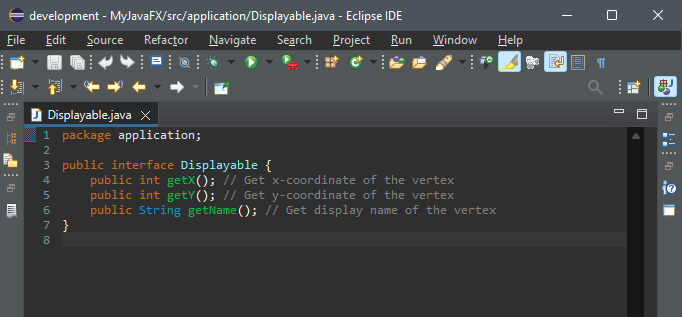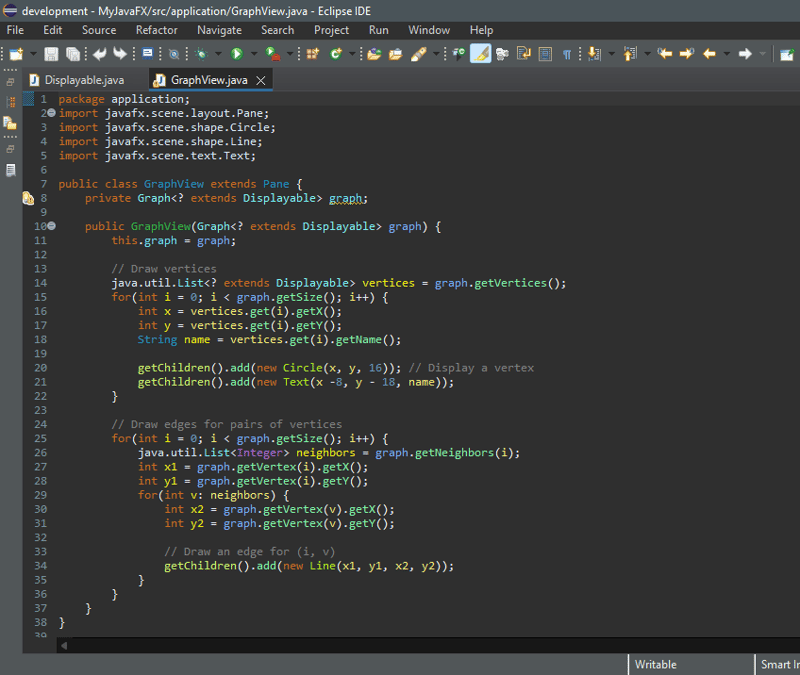Graph Visualization
To display a graph visually, each vertex must be assigned a location. The preceding section introduced how to model a graph using the Graph interface, AbstractGraph class, and UnweightedGraph class. This section discusses how to display graphs graphically. In order to display a graph, you need to know where each vertex is displayed and the name of each vertex. To ensure a graph can be displayed, we define an interface named Displayable that has the methods for obtaining the x- and y-coordinates and their names, and make vertices instances of Displayable, in the code below.

A graph with Displayable vertices can now be displayed on a pane named GraphView, as shown in the code below.

To display a graph on a pane, simply create an instance of GraphView by passing the graph as an argument in the constructor (line 9). The class for the graph’s vertex must implement the Displayable interface in order to display the vertices (lines 13–22). For each vertex index i, invoking graph.getNeighbors(i) returns its adjacency list (line 26). From this list, you can find all vertices that are adjacent to i and draw a line to connect i with its adjacent vertex (lines 27–34).

The code below gives an example of displaying the graph in Figure above, as shown in Figure below.

import javafx.application.Application;
import javafx.scene.Scene;
import javafx.stage.Stage;
public class DisplayUSMap extends Application {
@Override // Override the start method in the Application class
public void start(Stage primaryStage) {
City[] vertices = {new City("Seattle", 75, 50),
new City("San Francisco", 50, 210),
new City("Los Angeles", 75, 275), new City("Denver", 275, 175),
new City("Kansas City", 400, 245),
new City("Chicago", 450, 100), new City("Boston", 700, 80),
new City("New York", 675, 120), new City("Atlanta", 575, 295),
new City("Miami", 600, 400), new City("Dallas", 408, 325),
new City("Houston", 450, 360)};
// Edge array for graph
int[][] edges = {
{0, 1}, {0, 3}, {0, 5}, {1, 0}, {1, 2}, {1, 3},
{2, 1}, {2, 3}, {2, 4}, {2, 10},
{3, 0}, {3, 1}, {3, 2}, {3, 4}, {3, 5},
{4, 2}, {4, 3}, {4, 5}, {4, 7}, {4, 8}, {4, 10},
{5, 0}, {5, 3}, {5, 4}, {5, 6}, {5, 7},
{6, 5}, {6, 7}, {7, 4}, {7, 5}, {7, 6}, {7, 8},
{8, 4}, {8, 7}, {8, 9}, {8, 10}, {8, 11},
{9, 8}, {9, 11}, {10, 2}, {10, 4}, {10, 8}, {10, 11},
{11, 8}, {11, 9}, {11, 10}
};
Graph graph = new UnweightedGraph(vertices, edges);
// Create a scene and place it in the stage
Scene scene = new Scene(new GraphView(graph), 750, 450);
primaryStage.setTitle("DisplayUSMap"); // Set the stage title
primaryStage.setScene(scene); // Place the scene in the stage
primaryStage.show(); // Display the stage
}
public static void main(String[] args) {
Application.launch(args);
}
static class City implements Displayable {
private int x, y;
private String name;
City(String name, int x, int y) {
this.name = name;
this.x = x;
this.y = y;
}
@Override
public int getX() {
return x;
}
@Override
public int getY() {
return y;
}
@Override
public String getName() {
return name;
}
}
}
The class City is defined to model the vertices with their coordinates and names (lines 39–63). The program creates a graph with the vertices of the City type (line 30). Since City implements Displayable, a GraphView object created for the graph displays the graph in the pane (line 33).
-
 How to Fix the \"no display name and no $DISPLAY environment variable\" Error in Matplotlib?"_tkinter.TclError: no display name and no $DISPLAY environment variable"This error typically occurs when running a Python script using Matp...Programming Published on 2024-11-05
How to Fix the \"no display name and no $DISPLAY environment variable\" Error in Matplotlib?"_tkinter.TclError: no display name and no $DISPLAY environment variable"This error typically occurs when running a Python script using Matp...Programming Published on 2024-11-05 -
 Your First Backend Application using Node.jsAre you learning web development and confused about how to start a Node.js project? Don’t worry, I’ve got you! I’ll guide you through creating your fi...Programming Published on 2024-11-05
Your First Backend Application using Node.jsAre you learning web development and confused about how to start a Node.js project? Don’t worry, I’ve got you! I’ll guide you through creating your fi...Programming Published on 2024-11-05 -
 When Does CORS Use a Preflight Request in Cross-Domain Scenarios?CORS: Understanding the 'Preflight' Request for Cross-Domain RequestsCross-origin resource sharing (CORS) poses challenges when making HTTP re...Programming Published on 2024-11-05
When Does CORS Use a Preflight Request in Cross-Domain Scenarios?CORS: Understanding the 'Preflight' Request for Cross-Domain RequestsCross-origin resource sharing (CORS) poses challenges when making HTTP re...Programming Published on 2024-11-05 -
 How to filter files by extension using PHP\'s glob() function?Filtering Files by Extension in PHPWhen working with directories, it is often necessary to retrieve specific files based on their extension. PHP provi...Programming Published on 2024-11-05
How to filter files by extension using PHP\'s glob() function?Filtering Files by Extension in PHPWhen working with directories, it is often necessary to retrieve specific files based on their extension. PHP provi...Programming Published on 2024-11-05 -
 Understanding Promises and Promise Chaining in JavaScriptWhat is a Promise? A Promise in JavaScript is like a “promise” you make to do something in the future. It is an object that represents the ev...Programming Published on 2024-11-05
Understanding Promises and Promise Chaining in JavaScriptWhat is a Promise? A Promise in JavaScript is like a “promise” you make to do something in the future. It is an object that represents the ev...Programming Published on 2024-11-05 -
 Safe AssignmentThere was a good bit of buzz today about the new proposal for a safe assignment operator (?=) in JavaScript. I love how JavaScript has improved over t...Programming Published on 2024-11-05
Safe AssignmentThere was a good bit of buzz today about the new proposal for a safe assignment operator (?=) in JavaScript. I love how JavaScript has improved over t...Programming Published on 2024-11-05 -
 Create a Queue interfaceCreation of an interface for character queues. Three implementations to be developed: Fixed-size linear queue. Circular queue (reuses array space). D...Programming Published on 2024-11-05
Create a Queue interfaceCreation of an interface for character queues. Three implementations to be developed: Fixed-size linear queue. Circular queue (reuses array space). D...Programming Published on 2024-11-05 -
 When is Pip\'s Editable Mode Useful for Local Python Package Development?Leveraging Editable Mode for Local Package Development in Python using PipIn Python's package management ecosystem, Pip boasts the '-e' (o...Programming Published on 2024-11-05
When is Pip\'s Editable Mode Useful for Local Python Package Development?Leveraging Editable Mode for Local Package Development in Python using PipIn Python's package management ecosystem, Pip boasts the '-e' (o...Programming Published on 2024-11-05 -
 What Happens When You Type a URL Into a Browser?Have you ever wondered what happens behind the scenes when you type a URL into your browser and hit Enter? The process is more intricate than you migh...Programming Published on 2024-11-05
What Happens When You Type a URL Into a Browser?Have you ever wondered what happens behind the scenes when you type a URL into your browser and hit Enter? The process is more intricate than you migh...Programming Published on 2024-11-05 -
 How to Effectively Manage \"OutOfMemoryError: GC overhead limit exceeded\" for Numerous Small HashMap Objects?OutOfMemoryError: Handling Garbage Collection OverheadIn Java, the error "java.lang.OutOfMemoryError: GC overhead limit exceeded" occurs whe...Programming Published on 2024-11-05
How to Effectively Manage \"OutOfMemoryError: GC overhead limit exceeded\" for Numerous Small HashMap Objects?OutOfMemoryError: Handling Garbage Collection OverheadIn Java, the error "java.lang.OutOfMemoryError: GC overhead limit exceeded" occurs whe...Programming Published on 2024-11-05 -
![Why Do Lists Linked Together When Using [[]] * n in Python List Initialization?](/style/images/moren/moren.png) Why Do Lists Linked Together When Using [[]] * n in Python List Initialization?List Linking Issue in List Initialization with [[]] * nWhen initializing a list of lists using [[]] n, programmers often encounter an unexpected issu...Programming Published on 2024-11-05
Why Do Lists Linked Together When Using [[]] * n in Python List Initialization?List Linking Issue in List Initialization with [[]] * nWhen initializing a list of lists using [[]] n, programmers often encounter an unexpected issu...Programming Published on 2024-11-05 -
 Python Made Simple: Beginner to Advanced | BlogPython Course Code Examples This is a Documentation of the python code i used and created , for learning python. Its easy to understand and L...Programming Published on 2024-11-05
Python Made Simple: Beginner to Advanced | BlogPython Course Code Examples This is a Documentation of the python code i used and created , for learning python. Its easy to understand and L...Programming Published on 2024-11-05 -
 Simplifying Type Narrowing and Guards in TypeScriptIntroduction to Narrowing Concept Typescript documentation explains this topic really well. I am not going to copy and paste the same descrip...Programming Published on 2024-11-05
Simplifying Type Narrowing and Guards in TypeScriptIntroduction to Narrowing Concept Typescript documentation explains this topic really well. I am not going to copy and paste the same descrip...Programming Published on 2024-11-05 -
 When Should session_unset() Be Used Instead of session_destroy() and Vice Versa?Understanding the Distinction between session_unset() and session_destroy() in PHPThe PHP functions session_unset() and session_destroy() serve differ...Programming Published on 2024-11-05
When Should session_unset() Be Used Instead of session_destroy() and Vice Versa?Understanding the Distinction between session_unset() and session_destroy() in PHPThe PHP functions session_unset() and session_destroy() serve differ...Programming Published on 2024-11-05 -
 How to Choose the Best Approach for Parsing INI Files in C++?Parsing INI Files in C : A Guide to Various ApproachesWhen working with initialization (INI) files in C , developers often encounter the challenge o...Programming Published on 2024-11-05
How to Choose the Best Approach for Parsing INI Files in C++?Parsing INI Files in C : A Guide to Various ApproachesWhen working with initialization (INI) files in C , developers often encounter the challenge o...Programming Published on 2024-11-05
Study Chinese
- 1 How do you say "walk" in Chinese? 走路 Chinese pronunciation, 走路 Chinese learning
- 2 How do you say "take a plane" in Chinese? 坐飞机 Chinese pronunciation, 坐飞机 Chinese learning
- 3 How do you say "take a train" in Chinese? 坐火车 Chinese pronunciation, 坐火车 Chinese learning
- 4 How do you say "take a bus" in Chinese? 坐车 Chinese pronunciation, 坐车 Chinese learning
- 5 How to say drive in Chinese? 开车 Chinese pronunciation, 开车 Chinese learning
- 6 How do you say swimming in Chinese? 游泳 Chinese pronunciation, 游泳 Chinese learning
- 7 How do you say ride a bicycle in Chinese? 骑自行车 Chinese pronunciation, 骑自行车 Chinese learning
- 8 How do you say hello in Chinese? 你好Chinese pronunciation, 你好Chinese learning
- 9 How do you say thank you in Chinese? 谢谢Chinese pronunciation, 谢谢Chinese learning
- 10 How to say goodbye in Chinese? 再见Chinese pronunciation, 再见Chinese learning











![Why Do Lists Linked Together When Using [[]] * n in Python List Initialization?](http://www.luping.net/uploads/20241021/17294774536715bb4d76111.jpg)













